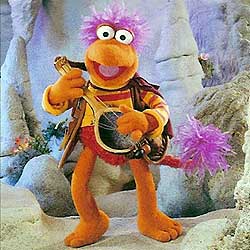It really depends on your budget and what you want to do.
The term "professional hand and rod puppet" is a misnomer, it doesn't really mean anything (I wrote
a short rant about that several years ago). Prices for custom puppets usually start at $500 and go up as high as $5k-$10k. Generally speaking, you get what you pay for. Buying a puppet is a lot like buying a car or a musical instrument...they may all look more or less the same on the outside, but it's the insides that matter.
Rates for puppeteers vary quite a bit as well. Puppeteers for film and TV who are members of unions like SAG or AFTRA (which is the majority of talented, experienced on-camera puppeteers in the United States) are usually paid what's known as "scale" which is the minimum pay rate required for a certain type of project. What you're doing would probably be classified as an "Ultra Low Budget" film, so I think the pay rate is around $250 per day or $900 per week, although the rate is often much higher on TV series and feature films. The pay rate for non-union puppeteers varies, but $100 per day for web-based projects seems to be the norm, although I know of experienced, talented non-union puppeteers who charge the same rates that are paid to union performers.
Pay for builders is all over the map too, at the last place I worked pay varied according to experience and skills. Trainees and interns made around $14-15 per hour and artists and technicians with specialized skills made $30-40 per hour. About $20-25 was the average though. Some shops - especially in theatre - are unionized and rates are set by the union. A really good builder whose work is demand can usually set their own rates within reason if they freelance.
Workshop size is variables as well. The last workshop I worked in was about 600sq feet, which was a good size for a flexible shop where several people worked, although we also took advantage of adjacent 800sq ft sound stage when extra space was needed (the 600sq ft does not take in to account a kitchen, bathroom, or office...that was just dedicated shop space). We had a lot machinery and storage though, without that we could have gotten away with less space.

 Welcome to the Muppet Central Forum!
Welcome to the Muppet Central Forum! Back to the Rock Season 2
Back to the Rock Season 2 Sesame Street Season 54
Sesame Street Season 54 The Muppets Mayhem premieres
The Muppets Mayhem premieres Bear arrives on Disney+
Bear arrives on Disney+ Sam and Friends Book
Sam and Friends Book But back to building, I want to learn how to do the flat polyurethane foam pattern technic more. I remember people recommending this website where you can buy learning kits for puppet patterns but they are too simple. Simple round head, simple tall head, etc. And I have a feeling that the puppets might come out too small. From noticing, hand puppets are usually a lot bigger in scale them the actual human arm that's inside which was new to me in my reason observation.
But back to building, I want to learn how to do the flat polyurethane foam pattern technic more. I remember people recommending this website where you can buy learning kits for puppet patterns but they are too simple. Simple round head, simple tall head, etc. And I have a feeling that the puppets might come out too small. From noticing, hand puppets are usually a lot bigger in scale them the actual human arm that's inside which was new to me in my reason observation.